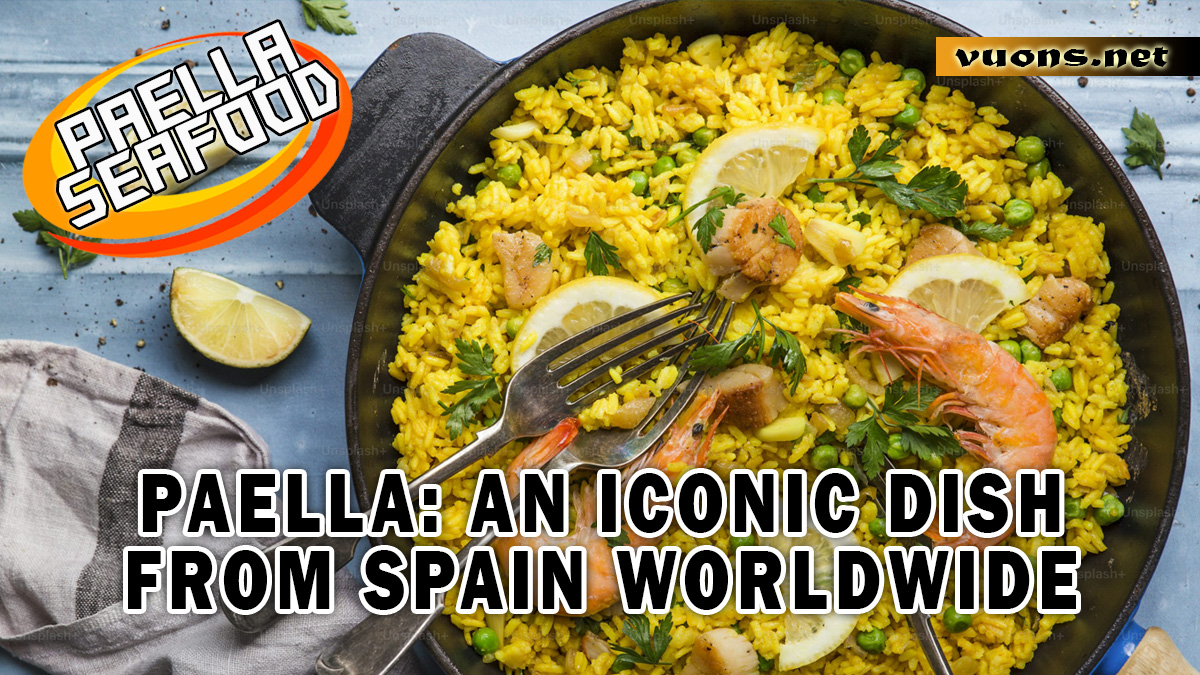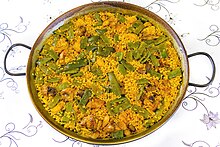Getting to Know Paella: An Iconic Dish from Spain
Getting to Know Paella: An Iconic Spanish Dish That’s Famous Worldwide
Paella is one of the most famous dishes from Spain, especially from the Valencia region. The name paella comes from “paellera,” which is a wide and shallow pan used to cook this dish. Initially, paella was a peasant Food made from simple ingredients such as rice, beans, chicken, and rabbit. However, over time, this dish has evolved and has many variations that are popular throughout the world.
Paella de mariscos or seafood paella is one of the most popular variants. This dish uses various types of seafood such as shrimp, clams, squid, and lobster, which give a strong and fresh sea flavor. Meanwhile, paella mixta combines chicken and seafood, giving a rich and varied flavor. The main ingredient that is no less important is Bomba or Calasparra rice, which is able to absorb the broth well without becoming mushy.
One of the distinctive elements in Getting to Know Paella: An Iconic Spanish Dish That’s Famous Worldwide is the use of saffron. The most expensive spice in the world gives the rice a bright yellow color and a distinctive aroma that is very appetizing. In addition to saffron, other spices such as paprika, garlic, and rosemary leaves also add to the richness of the paella flavor.
In cooking paella, a technique called “socarrat” is an important part. Socarrat is a rice crust that forms on the bottom of the pan when rice is cooked without stirring. This part is considered a special delicacy that gives a crispy and slightly caramelized texture to the dish. Paella is often served directly from the paellera pan with the addition of fresh lemon slices, which provide a refreshing touch of sourness. This dish is usually the main menu at family events or celebrations, making it a symbol of togetherness and Spanish culinary tradition.
The Secret to Making the Perfect Socarrat in Your Paella
The secret to making the perfect socarrat in your paella lies in the right cooking technique and the use of a special pan, the paellera. Socarrat is the crust of rice that forms on the bottom of the pan when the paella is cooked, giving it a savory caramel flavor and a crispy texture. In Spain, socarrat is considered the best part of paella, creating a different taste sensation in every mouthful.
To get the perfect socarrat, first make sure you use the right rice, such as Bomba or Calasparra rice. This type of rice is able to absorb the broth well without becoming mushy. When cooking, use medium to high heat to ensure that the rice on the bottom of the pan can form a crust.
The use of saffron and a rich broth also play an important role in creating a delicious socarrat. Saffron not only gives the rice its yellow color but also enhances the aroma and flavor of the dish. When the broth is almost gone and the rice looks cooked, increase the heat for the last 1-2 minutes to help the crust form. You should hear a slight frying sound as the socarrat begins to form.
Once done, remove the pan from the heat and let it sit for a few minutes before serving. This helps the crust to set and lift off easily when served. The perfect socarrat will be golden brown, crispy, and have a distinctive savory flavor. Serve the paella straight from the pan with fresh lemon slices for added freshness. With the right technique, you can enjoy the perfect socarrat in every bite of your paella.
Guide to Choosing the Best Ingredients for Authentic Paella
The Guide to Choosing the Best Ingredients for Authentic Paella begins with choosing the right rice. Rice is the main ingredient that cannot be substituted carelessly. For best results, use Bomba or Calasparra rice. Both types of rice are native to Spain and have the ability to absorb broth perfectly without becoming mushy, giving the paella the ideal texture.
Broth is another important key in the Guide to Choosing the Best Ingredients for Authentic Paella. A rich broth is the base of every variation of paella. For Paella Valenciana, use chicken or rabbit broth. Meanwhile, for Paella de Mariscos (seafood paella), seafood broth made from boiled shrimp heads and shells is highly recommended so that the dish has a strong seafood flavor.
Spices such as saffron, paprika, and garlic also play an important role in providing authentic flavors. Saffron is a spice that should not be overlooked because it gives the paella its distinctive yellow color and fragrant aroma. Although expensive, a little saffron can go a long way to transform the flavors of a dish into something more authentic and delicious.
For your protein choices, use fresh ingredients depending on the type of paella you’re making. Chicken and rabbit are classic choices for Paella Valenciana, while for Paella de Mariscos, opt for fresh shrimp, clams, and squid. Vegetables like green beans, tomatoes, and garrofó beans (a local Spanish bean) add texture and color to the dish.
Pure Spanish olive oil is the best choice for sautéing the spices, giving them a distinctive aroma and rich flavor. By choosing high-quality ingredients, you can create an authentic and mouth-watering paella.
The History and Evolution of Paella: From Valencian Farmers to the World
The history and evolution of paella: From Valencian Farmers to the World began in the 18th century in the rural region of Valencia, Spain. Originally, paella was a simple meal for farmers and farm workers who cooked rice in a large pan with ingredients available to them, such as chicken, rabbit, and beans. The dish was often cooked over an open fire, making it a practical and nutritious meal that could be enjoyed with family or friends.
The name “paella” itself comes from the word “paellera,” which is the typical pan used to cook the dish. Over time, the recipe for paella has changed and varied, depending on the local ingredients available in different regions of Spain. For example, in coastal areas, fishermen added seafood such as shrimp, clams, and squid to paella, creating a version known as Paella de Mariscos.
In the early 20th century, paella began to be known outside of Spain, especially in European and Latin American countries, thanks to Spanish immigrants who brought the recipe to other parts of the world. The History and Evolution of Paella: From Valencian Farmers to the World was also influenced by the rise of tourism in Spain in the mid-20th century. Travelers visiting the beaches of Valencia were captivated by the dish and took it home as an unforgettable culinary memory.
Today, paella has become an iconic dish that is often served at international festivals and events. In fact, in many restaurants around the world, paella has adapted to local flavors, adding ingredients such as chorizo sausage or seasonal vegetables. Despite its evolution, paella has retained its essence as a dish that brings people together and reflects the richness of Spanish culinary culture.




